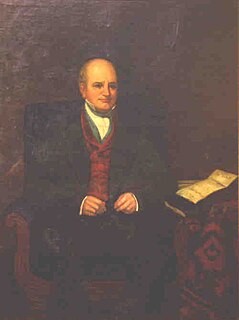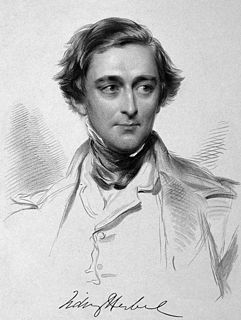
Sir Frederick Augustus Abel, 1st Baronet GCVO, KCB, FRS was an English chemist.

John Somerset Pakington, 1st Baron Hampton,, known as Sir John Pakington, Bt, from 1846 to 1874, was a British Conservative politician.
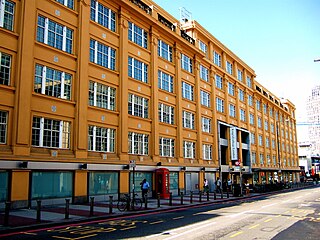
The Florence Nightingale Faculty of Nursing, Midwifery & Palliative Care is an academic faculty within King's College London. The faculty is the world's first nursing school to be continuously connected to a fully serving hospital and medical school. Established on 9 July 1860 by Florence Nightingale, the founder of modern nursing, it was a model for many similar training schools through the UK, Commonwealth and other countries for the latter half of the 19th century. It is primarily concerned with the education of people to become nurses and midwives. It also carries out nursing research, continuing professional development and postgraduate programmes. The Faculty forms part of the Waterloo campus on the South Bank of the River Thames and is now one of the largest faculties in the university.
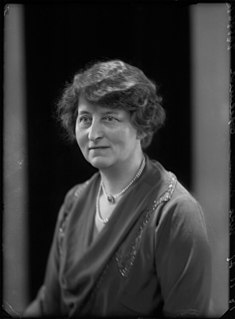
Ida Copeland was an Anglo-Italian British politician. She was active in social welfare both locally and nationally, particularly the Girl Guides, and was one of the earliest women to join Parliament, sitting as a Conservative MP for Stoke on Trent from 1931–35.
Rosalind Frances Nash, née Shore-Smith (1862–1952) was a niece and confidante of Florence Nightingale. She assisted in some of Nightingale's publications, and wrote on her behalf to Karl Pearson, when Pearson was writing his biography of Francis Galton.

The Derbyshire Royal Infirmary was a hospital in Derby that was managed by the Derby Teaching Hospitals NHS Foundation Trust. Following the transfer of community services to the London Road Community Hospital located further south-east along London Road, the infirmary closed in 2009 and most of the buildings were demolished in spring 2015.

John Sutherland was a physician and promoter of sanitary science.
Mervin Vavasour was a member of the Royal Engineers, one of the corps of the British Army.
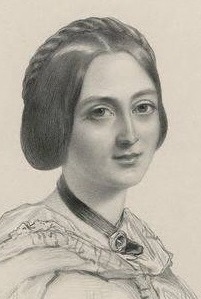
Mary Elizabeth Herbert, Baroness Herbert of Lea, known simply as Elizabeth Herbert, was an English Roman Catholic writer, translator, philanthropist, and influential social figure.
Henry Young Darracott Scott RE (1822–1883) was an English Major-General in the Corps of Royal Engineers, best known for the construction of London's Royal Albert Hall.

The Lady With A Lamp is a 1951 British historical film directed by Herbert Wilcox and starring Anna Neagle, Michael Wilding and Felix Aylmer. The film depicts the life of Florence Nightingale and her work with wounded British soldiers during the Crimean War.

Thomas Graham Balfour was a Scottish physician noted for his work with medical statistics, and a member of Florence Nightingale's inner circle.

Initially the Herbert Hospital, renamed in 1900, the Royal Herbert Hospital was built as a restorative facility for British veterans of the Crimean War, and remained a military hospital until 1977. It was situated in southeast London, on the south side of Woolwich Common, on the western slopes of Shooter's Hill, in the Royal Borough of Greenwich. Today the former hospital buildings form a residential development known as the Royal Herbert Pavilions.
The 1902 Coronation Honours were announced on 26 June 1902, the date originally set for the coronation of King Edward VII. The coronation was postponed because the King had been taken ill two days before, but he ordered that the honours list should be published on that day anyway.
The history of nursing in the United Kingdom tells of the development of the profession since the 1850s. The history of nursing itself dates back to ancient times, when the sick were cared for in temples and houses of worship. In the early Christian era, nursing in the United Kingdom was undertaken by certain women in the Church, their services being extended to patients in their homes. These women had no real training by today's standards, but experience taught them valuable skills, especially in the use of herbs and folk drugs, and some gained fame as the physicians of their era. Remnants of the religious nature of nurses remains in Britain today, especially with the retention of the job title "Sister" for a senior female nurse.
Galton is a surname and occasionally a given name. Notable people with the name include:
Beatrice Isabel Jones (1866–1921) was a British nurse, who after serving in several civilian hospitals, volunteered for military service. She served in the First Boer War in South Africa and then later served during World War I in Baghdad as Matron in Chief of Mesopotamia. She was one of the inaugural recipients of the Florence Nightingale Medal.

Major-General Sir George Joseph Hamilton Evatt KCB was a British Army officer and military doctor. He served overseas in the Perak War, Second Anglo-Afghan War, and Mahdist War, but was better known for his writings on military medicine and his lobbying for the creation of the Royal Army Medical Corps.


